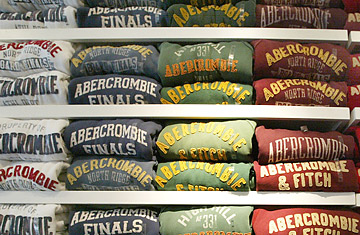
Abercrombie & Fitch sweatshirts are displayed in one of its stores in Chicago
In this recession, there are struggling apparel retailers all across the country. Then there's Abercrombie & Fitch. The upscale teen retailer has suffered 10 straight months of double-digit same-store-sales declines. In the second quarter of 2009 alone, sales were down an eye-popping 30% across the company's three name outlets: the flagship Abercrombie brand, which has 567 stores; Hollister, a 520-store teen chain; and Ruehl, a 29-store chain for young adults that Abercrombie shut down in June. Abercrombie & Fitch lost $26.7 million, which includes $24.4 million in charges associated with the closing of Ruehl, in the second quarter. During the same period in 2008, Abercrombie scored a $77.8 million profit. "Abercrombie has mismanaged this economic downturn more than any other retailer," says Britt Beemer, CEO of America's Research Group, a retail consulting firm.
What lessons can be learned from the Abercrombie experience? The first has to do with pricing. As the economy spiraled downward and competitors like Aéropostale started discounting like crazy, Abercrombie refused to lower prices. The company insisted that price-cutting would cheapen the cachet of the brand.
You would figure that discounting would provide goodwill and build customer loyalty, especially in lean times. After all, with more grateful customers in tow, wouldn't the company be in a great position to ride the upswing associated with an economic recovery, raising prices again when times get better?
Not necessarily, say consumer experts. "According to various research findings, a company will have a tough time increasing prices once they've lowered them," says C.W. Park, a marketing professor at the University of Southern California and editor of the Journal of Consumer Psychology. "Shoppers start to think the discounts are the base prices, and you risk alienating the shoppers if you raise them. Logically, you'd think that consumers would appreciate the lower prices and be understanding when they go back up. It doesn't always work that way."
But even if Abercrombie could justify holding firm on price, it did little else to entice customers. "If you provide interesting incentives, you can minimize losses while maintaining the luxury image," says Park. "Offer milk and cookies in the store. Anything."
He points to the Four Seasons hotel chain, which still charges premium prices for its rooms but started offering deals that let you buy a two-night stay and get a third one free. The hotel, in effect, is lowering its prices. But when things improve, it will be easier for consumers to accept the end of the free-room deal than a sudden spike in prices. We know you can't give away rooms, but how can you jack prices up another $30? Although Abercrombie holds seasonal clearance sales, it shuns such regular promotions.
Abercrombie is having other problems. "They were the quintessential American prep brand, but the world changed on them," says Edward Yruma, an equity research analyst at KeyBanc Capital Markets. "We're living in the Gossip Girl era, where we're seeing some funkier fashions." Abercrombie's classic look went out of style, and the company is just starting to sell dresses, which have performed well. "I've noticed that my kids aren't open to anything Abercrombie these days," says one mother of two teenage girls.
After releasing second-quarter earnings on Aug. 14, Abercrombie CEO Mike Jeffries admitted that the company missed some spring fashion trends. He said he plans to cut prices more aggressively. (The company did not respond to an interview request.) He might also want to change the Abercrombie vibe, which seems pretty tone-deaf to the times. At the New York City Abercrombie & Fitch store, whose neighbors include Prada and Gucci, a shirtless male model greets shoppers at the front and happily snaps pictures with the gawkers. Sales associates dance to hip-hop music in the aisles. There's not one "For Sale" sign in the whole four-story place. A pair of men's ripped jeans go for $90; women's jeans are $80; a hooded sweatshirt with the Abercrombie logo is $60.
Meanwhile, at the New York City Aéropostale, whose neighbors include J.C. Penney, no one is shirtless but everything is on sale. No half-nude model greets you at the front door, but a guy barking "Buy one pair of women's jeans, get another free" does. Sales associates don't dance; they tell you deals. Ripped jeans are $30; women's jeans sell for $49.50 (plus the freebie pair); the Aéropostale hoodie is $15, or a quarter of Abercrombie's price.
Think it's a coincidence that while Abercrombie's second-quarter profits fell 134%, Aéropostale's are up 83%?
When and if the economy heats up again, perhaps shoppers will return to the so-called aspirational brands like Abercrombie. But don't bet on it. "Retailers don't realize that consumers are spending less and doing O.K. with it," says Beemer. According to Beemer's research, only 40% of men and 20% of women say they'll spend at high-end apparel stores again. "Abercrombie keeps working to protect their brand," says Beemer. "But when you keep seeing 30% sales declines, you're going to protect your brand into oblivion."
